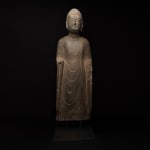Northern Qi Stone Standing Buddha, 550 CE - 577 CE
Stone
94 x 27.9 cm
37 x 11 in
37 x 11 in
HK.2022
Further images
This sculpture of a Buddha has an oval face and a small full mouth. The features are highly stylized, the eyes are elongated, under arched brows. The chin is rounded,...
This sculpture of a Buddha has an oval face and a small full mouth. The features are highly stylized, the eyes are elongated, under arched brows. The chin is rounded, and slightly double chinned. The neck is smooth and columnar, with no fat rings, as are found more commonly after the Northern Qi. Although the parts are missing, we can confidently assume that the Buddha is originally depicted standing barefoot on a pedestal, with his hands forming the abhaya and varada mudra respectively, as is typical of its time. The Buddha’s simplistic sanghati is elegantly and clearly carved.
Standing Buddha is a prominent form of sculpture under the patronage of the Northern Wei imperial family, who commissioned the carving of rock caves in Longmen and Gongxian, both in Henan province, in the first quarter of the 6th century, which typically show seated or standing Buddhas flanked by two bodhisattvas. Besides these massive stone carvings in cave temples, many free-standing steles, also often with two bodhisattva figures on either side of a central Buddha statue, were commissioned in that century, which followed the artistic language introduced by these grand Buddhist cave sculpture projects, which exerted an overwhelming influence on Chinese sculpture of the period in general.
This majestic figure of a Buddha has fine, even facial features, with particular attention paid to its elegant garment and loose sleeves. The low-relief carving style and almost complete disregard for the shape of the body under the garments is characteristic of the Northern Qi period. Unlike the subsequent Sui style, sculptors during Northern Dynasties period were less interested in rendering the three-dimensional physical side of a deity figure than in capturing its spiritual message through delicate facial features and gestures.
Standing Buddha is a prominent form of sculpture under the patronage of the Northern Wei imperial family, who commissioned the carving of rock caves in Longmen and Gongxian, both in Henan province, in the first quarter of the 6th century, which typically show seated or standing Buddhas flanked by two bodhisattvas. Besides these massive stone carvings in cave temples, many free-standing steles, also often with two bodhisattva figures on either side of a central Buddha statue, were commissioned in that century, which followed the artistic language introduced by these grand Buddhist cave sculpture projects, which exerted an overwhelming influence on Chinese sculpture of the period in general.
This majestic figure of a Buddha has fine, even facial features, with particular attention paid to its elegant garment and loose sleeves. The low-relief carving style and almost complete disregard for the shape of the body under the garments is characteristic of the Northern Qi period. Unlike the subsequent Sui style, sculptors during Northern Dynasties period were less interested in rendering the three-dimensional physical side of a deity figure than in capturing its spiritual message through delicate facial features and gestures.











